Each room has audiovisual terminals where visitors can listen to stories of various important historical persons. When not in use creepy silhouetted ghosts float across the screen, presumable to evoke the spirits whose history haunts the house. People learn in different ways and having different kinds of entry points into the information on display is important, but I still believe that audiovisuals are largely a waste of time and money and I rarely see anyone more engaged with one than they would be with an exhibit.
I really like it when exhibitions include a panel that names the people responsible for its execution. Doing so indicates that the museum is not an anonymous authority and in theory it provides the staff with a certain amount of accountability. The permanent collection was reworked by a large group of people included half a dozen translators and editors. Knowing this makes forgiving their errors much more difficult. It amazes me that museums can present text to their visitors that is riddled with errors, and one would think that with 6 people working on editing there wouldn’t be any labels that repeat the same paragraph twice, contain misspelled artists' names or have improper terminology. Can we get past clichés like the "here the walls speak," or "the spirit of the past haunts these rooms?"
It’s a shame because the museum presents lots of good information to the public. There are consise yet thorough historical breakdowns that provide needed context as well as unique tidbits that make one museum stand out from the rest. A portrait of Ben Franklin is displayed because a reception was held for him at the Chateau, and this artifact is used as an opportunity to talk about Canada’s relationship with the United States at that time. Maps and paintings for each time period illustrate Montreal’s changing landscape.

Let's Eat is a temporary exhibit that recounts the history of Quebecois cuisine. The quirky and enjoyable exhibit is the by-product of developments in food history. We learn that the 17th century church considered beaver to be a fish and the Quebecois sugar shack meal is a product of British kitchens. The exhibit compares our eating habits to that of our ancestors, explores the history of 10 of the provinces most popular dishes, and asks us to guess which products would not have been used centuries ago. Its a unique and very interesting entry point into our history.
18 down. 14 to go.






